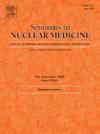18F-FDG PET用于痴呆评估:共病、新疾病及其在抗淀粉样蛋白治疗时代的作用。
IF 5.9
2区 医学
Q1 RADIOLOGY, NUCLEAR MEDICINE & MEDICAL IMAGING
引用次数: 0
摘要
痴呆症会损害一个人的认知能力和日常工作能力,通常由神经退行性疾病引起,仍然是最具挑战性的神经精神疾病之一。在老龄化社会中,痴呆症的患病率一直在稳步上升。最近,抗淀粉样蛋白治疗已被开发并批准用于治疗阿尔茨海默病(AD),这是众所周知的痴呆症的主要原因。这样的治疗发展加速了体内生物标志物在研究、临床试验和临床实践中的应用。包括18f -氟脱氧葡萄糖(FDG)正电子发射断层扫描(PET)在内的几种生物标志物的过去和最近的发展,在了解痴呆疾病的潜在机制和加速研究和临床实践的进展方面发挥了关键作用,从而导致更准确的临床诊断,识别共同病理,更好地了解新疾病,治疗计划和反应评估。本文综述了脑FDG PET作为一种成熟的成像生物标志物,作为研究脑代谢的有价值工具及其在临床和研究环境中的应用,特别是在治疗痴呆症方面的应用。本文章由计算机程序翻译,如有差异,请以英文原文为准。
18F-FDG PET for Dementia Evaluation: Co-pathologies, New Diseases, and Its Roles in the Era of Antiamyloid Treatment
Dementia, which impairs a person's cognition and ability in daily tasks and is often caused by neurodegenerative disorders, remains one of the most challenging neuropsychiatric conditions. The prevalence of dementia has been steadily increasing in aging societies. Recently, antiamyloid treatment has been developed and approved for the treatment of Alzheimer’s disease (AD), which is known as the major cause of dementia. Such therapeutic developments have accelerated the use of in vivo biomarkers in research, clinical trials, and clinical practice. Past and recent developments of several biomarkers, including 18F-fluorodeoxyglucose (FDG) positron emission tomography (PET), have played a pivotal role in understanding the underlying mechanisms of dementing disorders and accelerating progress in both research and clinical practice, leading to more accurate clinical diagnosis, recognition of co-pathologies, better understanding of new diseases, treatment planning, and response evaluation. This article reviews the roles of brain FDG PET, one of the well-established imaging biomarkers, as a valuable tool for studying brain metabolism and its applications in clinical and research settings, particularly for the treatment of dementia.
求助全文
通过发布文献求助,成功后即可免费获取论文全文。
去求助
来源期刊

Seminars in nuclear medicine
医学-核医学
CiteScore
9.80
自引率
6.10%
发文量
86
审稿时长
14 days
期刊介绍:
Seminars in Nuclear Medicine is the leading review journal in nuclear medicine. Each issue brings you expert reviews and commentary on a single topic as selected by the Editors. The journal contains extensive coverage of the field of nuclear medicine, including PET, SPECT, and other molecular imaging studies, and related imaging studies. Full-color illustrations are used throughout to highlight important findings. Seminars is included in PubMed/Medline, Thomson/ISI, and other major scientific indexes.
 求助内容:
求助内容: 应助结果提醒方式:
应助结果提醒方式:


